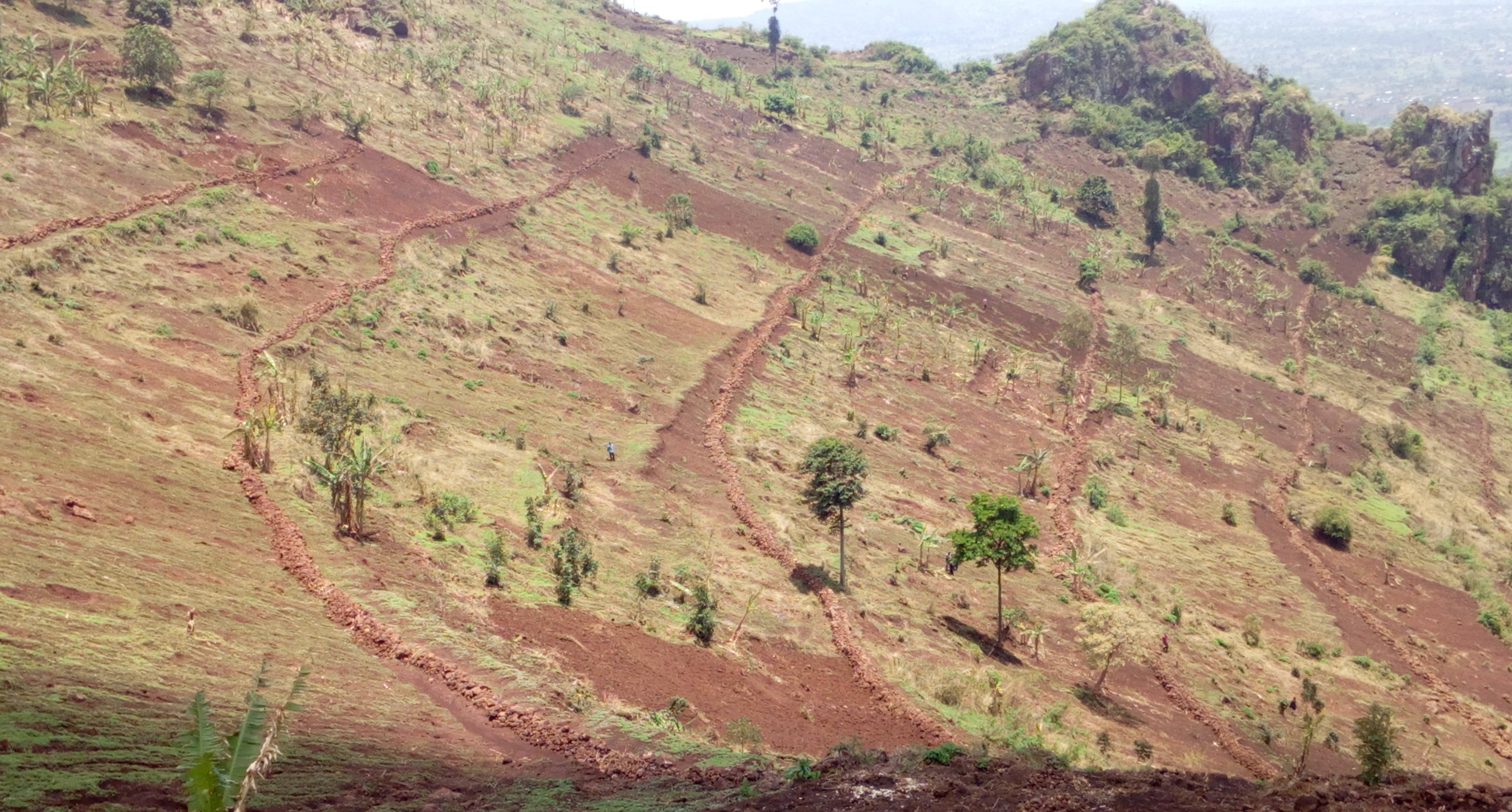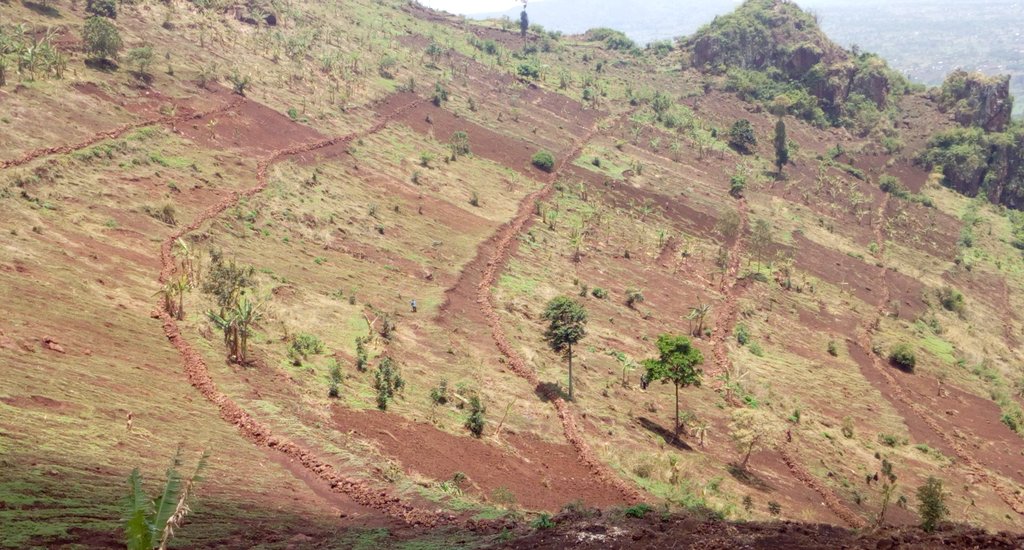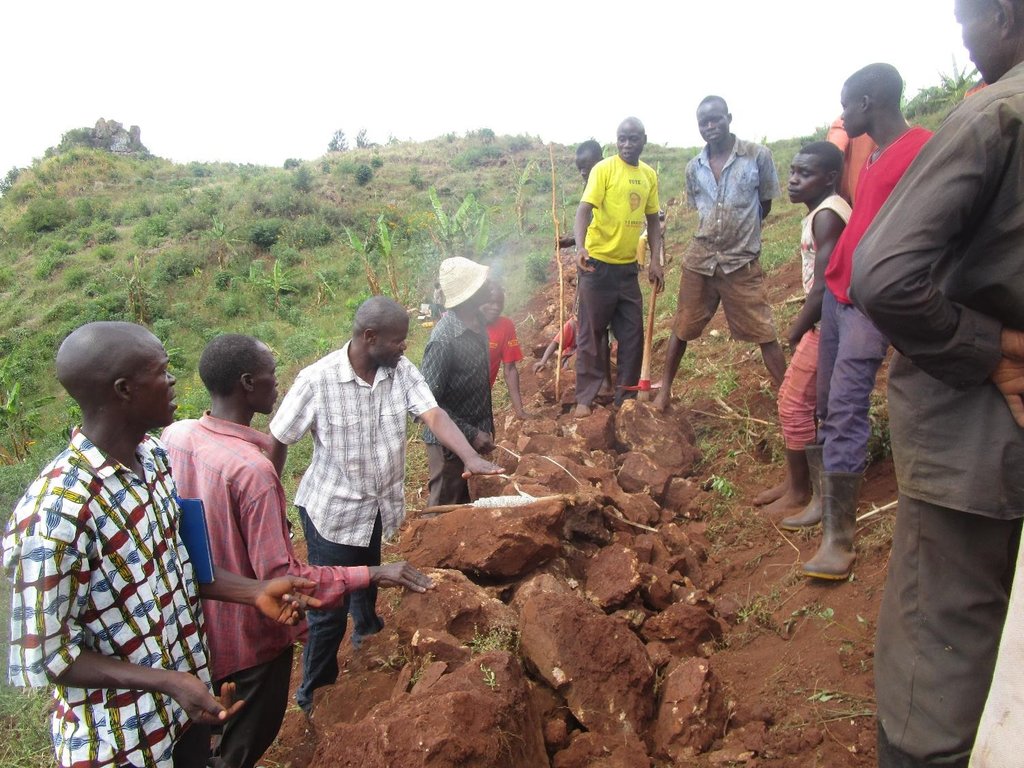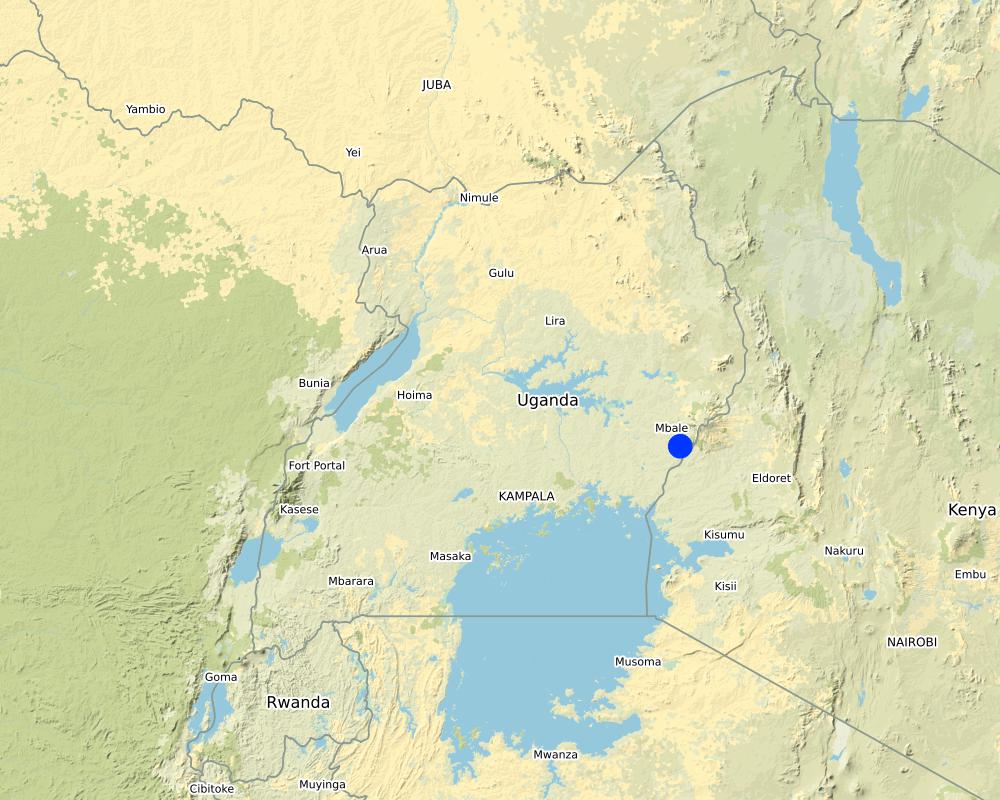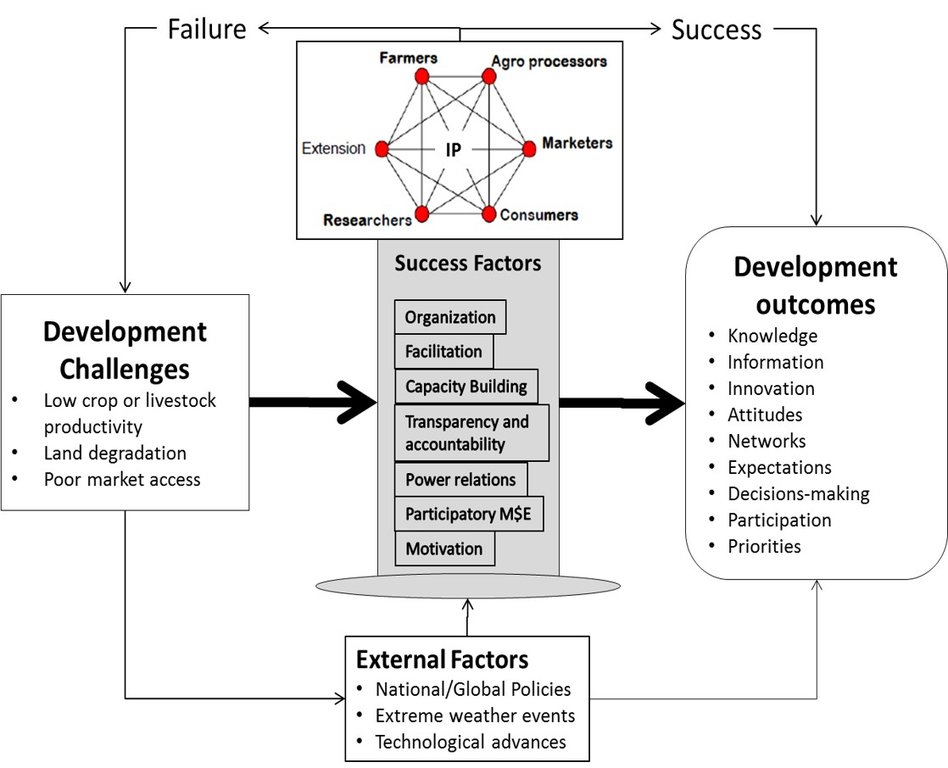Innovation Platform Approach (IPA) for Collective Action in SLM [ອູເຈນດາ]
- ການສ້າງ:
- ປັບປູງ:
- ຜູ້ສັງລວມຂໍ້ມູນ: Bernard Fungo
- ບັນນາທິການ: Dr. Patrick Musinguzi, Moses Makooma Tenywa, Kamugisha Rick Nelson
- ຜູ້ທົບທວນຄືນ: Nicole Harari, Udo Höggel
Tubaana Group
approaches_4041 - ອູເຈນດາ
ເບິ່ງພາກສ່ວນ
ຂະຫຍາຍທັງໝົດ ຍຸບທັງໝົດ1. ຂໍ້ມູນທົ່ວໄປ
1.2 ລາຍລະອຽດ ການຕິດຕໍ່ ຂອງບຸກຄົນທີ່ຊັບພະຍາກອນ ແລະ ສະຖາບັນ ການມີສ່ວນຮ່ວມ ໃນການປະເມີນຜົນ ແລະ ເອກະສານ ຂອງວິທີທາງ
ຊື່ຂອງໂຄງການ ທີ່ອໍານວຍຄວາມສະດວກ ໃນການສ້າງເອກກະສານ ຫຼື ປະເມີນດ້ານແນວທາງ (ຖ້າກ່ຽວຂ້ອງ)
Scaling-up SLM practices by smallholder farmers (IFAD)ຊື່ຂອງ ສະຖາບັນການຈັດຕັ້ງ ທີ່ອໍານວຍຄວາມສະດວກ ໃນການສ້າງເອກກະສານ ຫຼື ປະເມີນແນວທາງ (ຖ້າກ່ຽວຂ້ອງ)
Uganda Landcare Network (ULN) - ອູເຈນດາ1.3 ເງື່ອນໄຂ ຂອງການນໍາໃຊ້ເອກກະສານຂໍ້ມູນ ຂອງ WOCAT
ເມື່ອໃດທີ່ໄດ້ສັງລວມຂໍ້ມູນ (ຢູ່ພາກສະໜາມ)?
12/09/2016
ຜູ້ສັງລວມ ແລະ ບັນດາຜູ້ຕອບແບບສອບຖາມ ຍອມຮັບໃນເງື່ອນໄຂ ການນໍາໃຊ້ຂໍ້ມູນເອກະສານ ທີ່ສ້າງຂື້ນ ໂດຍຜ່ານ ອົງການ WOCAT:
ແມ່ນ
2. ພັນລະນາ ແນວທາງການຄຸ້ມຄອງນໍາໃຊ້ດິນແບບຍືນຍົງ
2.1 ການອະທິບາຍ ໂດຍຫຍໍ້ ຂອງວິທີທາງ
Critical actors in a certain area come together, articulate the perceived challenge, identify solutions, allocate responsibilities and work together towards overcoming the challenge
2.2 ການອະທິບາຍ ລາຍລະອຽດ ຂອງວິທີທາງ
ການອະທິບາຍ ລາຍລະອຽດ ຂອງວິທີທາງ:
Efficient use of natural resources is a critical pathway to achieving green growth. Mountain ecosystems are an example of natural resources that need to be sustainably managed to continue providing economic, social and environmental benefits to the large number of dependent communities. The challenge is that these ecosystems are fragile and highly susceptible to natural disasters and their management requires multi-sectoral, transboundary, interdisciplinary and landscape level interventions. Although several technologies to address land degradation exist, adoption remains low. This has been attributed mainly to a dysfunctional extension system and weak implementation of land management policies/regulations. Working at landscape-scale and ensuring inter-sectoral coordination and cooperation is crucial for effective land management responses.
An Innovation Platform (IP) approach is a mechanism to enhance communication and innovation capacity among mutually dependent actors, by improving interactions, coordination, and coherence among all actors to facilitate learning and contribute to production and use of knowledge. The IP approach is a coalition, collaboration, partnership and alliance of agricultural research and development (ARD) actors. That is, public and private scientists, extension workers, representatives of farmers, farmers’ associations, private firms and non-governmental organizations and government policy makers.
Documentation of this approached is based on experience from a study conducted in the eastern highlands of Uganda. The aim of this study was to improve the understanding of how IPs can enhance adoption of soil and water conservation technologies in the fragile highland ecosystems of eastern Uganda. Control of soil erosion was identified as a challenge to be addressed by the IP. The process involved the key principles as follows:
1. Establishment of an effective leadership – An IP committee was established and trained on critical skills required in group dynamics
2. Facilitating formation of lower-level groups (IP clusters) – this is not a necessary step but was important to implement soil erosion control in Bugobero micro-catchments
3. Capacity building – mainly on soil erosion control using contour bunds stabilized with multipurpose trees (Calliandra and Grevillea). This was done through the Farmer Field School (FFS) approach. Farmers were able to collectively establish 4,000 meters of contour bunds and reduce run-off and erosion significantly
4. Participatory Monitoring and Evaluation
5. Development and implementation of an effective communication strategy among stakeholder; and
6. Facilitating the formulation of by-laws to foster implementation of soil erosion control. A by-law on maintenance of the established contour bunds was initiated and the process is still on-going.
From this experience, the IP intends to implement the FFS approach on other technologies such as fodder-bank establishment from Calliandra along contours bunds, manure management for production and collective marketing of bananas. These interrelated technologies are contributing towards improving the banana value chain, which plays a significant role in the food and income security of a majority of households in eastern Uganda. Data collection on information flow and knowledge sharing among stakeholders is on-going to provides empirical evidence about the potential of this approach. The benefits demonstrated by the IP are a motivation for stakeholders to participate in collective action. The cycle of benefits can lead to a self-sustaining community.
The need to establish an IP can originate from various actors including researchers, farmers, development agencies, NGOs, private companies, entrepreneurs and agricultural artisans, among others. Once a common challenge has been identified, the vision bearer can begin to mobilize other actors and share visions.
The advantages of this approach include:
1. direct and continuous interaction, communication and knowledge sharing among the IP actors
2. quick and continuous feedback from end users (farmers) at all stages of research for development and;
3. timely integration of new knowledge into the innovation process using experiential learning, monitoring and evaluation and the continous feedback
One limitation of this approach is that it requires continuous motivation of the various actors to maintain their interest the IP. Often times the benefits of Natural Ressources Management, NRM are long-lived while most actors look for shorter term benefits, making it difficult to maintain motivation. Conflict is a common occurrence in such multi-stakeholder platforms and only transparent and accountable leadership can overcome this. Examples of situation where conflict situations arise include technology selection, labour distribution, financial and gender biases.
2.3 ຮູບພາບຂອງແນວທາງ
2.5 ປະເທດ / ເຂດ / ສະຖານທີ່ບ່ອນທີ່ແນວທາງໄດ້ຖືກນໍາໃຊ້
ປະເທດ:
ອູເຈນດາ
ພາກພື້ນ / ລັດ / ແຂວງ:
Manafwa District, Mount Elgon Region
ຂໍ້ມູນເພີ່ມເຕີມຂອງສະຖານທີ່:
Khabungu Parish, Bugobero Sub county
ຄວາມຄິດເຫັນ:
The site is located on the southern slopes of Mt Elgon
Map
×2.6 ວັນທີເລີ່ມຕົ້ນ ແລະ ສິ້ນສຸດ ການຈັດຕັ້ງປະຕີບັດ ວິທີທາງ
ສະແດງປີຂອງການເລີ່ມຕົ້ນ:
2016
2.7 ປະເພດຂອງແນວທາງ
- ພາຍໃຕ້ໂຄງການ / ແຜນງານ
2.8 ເປົ້າໝາຍ / ຈຸດປະສົງຫຼັກ ຂອງການຈັດຕັ້ງປະຕິບັດ ວິທີທາງ
Improve knowledge-sharing and dialogue among relevant actors in addressing a multi-stakeholder natural resource management challenge
2.9 ເງື່ອນໄຂອໍານວຍ ຫຼື ຂັດຂວາງການປະຕິບັດຂອງເຕັກໂນໂລຢີ / ເຕັກໂນໂລຢີການນໍາໃຊ້ຕາມແນວທາງ
ສັງຄົມ / ວັດທະນະທໍາ / ມາດຕະຖານ ແລະ ຄຸນຄ່າທາງສາສະໜາ
- ອໍານວຍ
Social capital in form of community cohesiveness encourages people to support the less-privileged such as the elderly, who cannot afford labour to construct contour bunds on their own
ມີຄວາມສາມາດ / ເຂັ້າເຖິງຊັບພະຍາກອນດ້ານການເງິນ ແລະ ການບໍລິການ
- ອໍານວຍ
Several microfinance institutions have be created with support from government of Uganda to farmer groups, although their priority is not much into natural resource management
- ເຊື່ອງຊ້ອນ
Stringent rules on payback periods and collateral make it difficult for most farmer groups on SLM to access
ການກໍ່ຕັ້ງສະຖາບັນ
- ອໍານວຍ
Existence of several farmer groups can support knowledge sharing
- ເຊື່ອງຊ້ອນ
Enforcement of land management laws inadequate
ການຮ່ວມມື / ການປະສານງານຂອງຜູ້ກ່ຽວຂ້ອງ
- ອໍານວຍ
Decentralization policy in the country
ນະໂຍບາຍ
- ອໍານວຍ
Decentralization policy in Uganda allows for establishment of local rules of engagement between farmers and local government
ຄວາມຮູ້ກ່ຽວກັບການຄຸ້ມຄອງ ທີ່ດິນແບບຍືນຍົງ, ການເຂົ້າເຖິງການສະໜັບສະໜູນ ທາງດ້ານວິຊາການ
- ອໍານວຍ
Several NGOs and projects are promoting land management practices due to frequent occurrence of landslides in the area
- ເຊື່ອງຊ້ອນ
The largely demand-driven farmer-paid extension system in Uganda does not allow for farmers to seek technical support on land management practices
ຕະຫຼາດ (ໃນການຊື້ວັດຖຸດິບ, ຂາຍຜະລິດຕະພັນ) ແລະ ລາຄາ
- ອໍານວຍ
Increasing population in has driven up the demand for food and agricultural supplies and this creates new markets for farmers' produce
- ເຊື່ອງຊ້ອນ
The difficult terrain makes access to markets terribly difficult for farmers
ວຽກ, ມີກໍາລັງຄົນ
- ເຊື່ອງຊ້ອນ
Shortage of labor due to youth migration to urban areas yet land management technologies are labor intensive
3. ການມີສ່ວນຮ່ວມ ແລະ ບົດບາດຂອງພາກສ່ວນທີ່ກ່ຽວຂ້ອງທີ່ໄດ້ມີສ່ວນຮ່ວມ
3.1 ຜູ້ມີສ່ວນຮ່ວມ ໃນວິທີທາງ ແລະ ພາລະບົດບາດ ຂອງເຂົາເຈົ້າ
- ຜູ້ນໍາໃຊ້ດິນໃນທ້ອງຖິ່ນ / ຊຸມຊົນທ້ອງຖິ່ນ
Farmers
Implement land management practices on their farms
- ຜູ້ຊ່ຽວຊານ ການນຄຸ້ມຄອງ ທີ່ດິນແບບຍືນຍົງ / ທີ່ປຶກສາດ້ານກະສິກໍາ
Agricultural Extension staff
Provide technical advise to farmers
- ນັກຄົ້ນຄວ້າ
National Agricultural Research Organization (NARO)
Study the technological, institutional and market approaches and processes for improving the functioning of the IP approach
- ອົງການຈັດຕັ້ງ ທີ່ບໍ່ຂື້ນກັບລັດຖະບານ
Mbale Coalition Against Poverty (Mbale-CAP)
Provision of farm inputs such as tree seedlings of appropriate species
- ພາກເອກະຊົນ
Input dealers, product dealers and banks
Provision of input such as seedlings to farmers and buying of produce such as bananas from farmers. Banks provide low-interest loans to farmers.
- ອໍານາດ ການປົກຄອງທ້ອງຖິ່ນ
Sub county local government
Support the process of preparation and enactment of by-laws of land management
- ອົງການຈັດຕັ້ງ ສາກົນ
International Research Centers (e.g. World Agroforetry Center)
Support research by providing extra expertise to national research centers and sometime laboratory facilities where needed
ຖ້າຫາກມີຫຼາຍພາກສ່ວນທີ່ເຂົ້າຮ່ວມ ໃຫ້ລະບຸ ອົງການທີ່ເປັນຫຼັກ ໃນການຈັດຕັ້ງປະຕິບັດ:
National Forestry Resources Research Institute (NaFORRI), National Agricultural Research Organization (NARO)
3.2 ການມີສ່ວນຮ່ວມຂອງຜູ້ນໍາໃຊ້ທີ່ດິນໃນທ້ອງຖິ່ນ / ຊຸມຊົນທ້ອງຖິ່ນໃນໄລຍະທີ່ແຕກຕ່າງກັນຂອງແນວທາງ
| ການລວບລວມ ເອົາຜູ້ນໍາໃຊ້ດິນ ໃນທ້ອງຖິ່ນ / ຊຸມຊົນທ້ອງຖິ່ນ | ໃຫ້ລະບຸ ຜູ້ໃດທີ່ມີສ່ວນຮ່ວມ ໃນແຕ່ລະກິດຈະກໍາ? | |
|---|---|---|
| ການເລີ່ມຕົ້ນ / ແຮງຈູງໃຈ | ການຊ່ວຍເຫຼືອຈາກພາຍນອກ | Some groups had already initiated some actions but were not very progressive. A research team came from the the National Research Institute to stimulate the organization of the group on soil erosion control. |
| ການວາງແຜນ | ການຮ່ວມມື | Farmers participated in the elections to establish the steering committee of the IP. They also participated in the visioning and articulation of the soil erosion challenge and the means to address it. Farmers also participated in the selection of technological options for soil erosion control. |
| ການປະຕິບັດ | ການຮ່ວມມື | Local leaders (Local Councils) participated in the formation of lower level IP clusters in each sub catchment and mobilizing households to participate in joint activities on designated days. Farmers participated in the collective action to establish soil erosion control structures across the landscape. |
| ຕິດຕາມກວດກາ / ການປະເມີນຜົນ | ການຮ່ວມມື | Farmers and local leaders were part of the monitoring and evaluation committee of the IP and participated in periodic activities to asses progress towards the set targets such as the extent and quality of contour bunds completed, the rate of soil erosion and the performance of the crops after the bunds are created. |
3.3 ແຜນວາດ (ຖ້າມີ)
ການອະທິບາຍ:
Flow Chart of the process that the IP approach needs to go through to be effective
ຜູ້ຂຽນ:
Bernard Fungo
3.4 ການຕັດສິນໃຈກ່ຽວກັບການຄັດເລືອກເຕັກໂນໂລຢີຂອງການຄຸ້ມຄອງທີ່ດິນແບບຍືນຍົງ / ເຕັກໂນໂລຢີ
ລະບຸ ຄົນທີ່ຕັດສິນໃຈ ກ່ຽວກັບການຄັດເລືອກຂອງ ເຕັກໂນໂລຢີ / ເຕັກໂນໂລຢີ ຈະໄດ້ຮັບການປະຕິບັດ:
- ພາກສ່ວນກ່ຽວຂ້ອງທັງໝົດ, ເປັນສ່ວນໜຶ່ງ ຂອງວິທີທາງແບບມີສ່ວນຮ່ວມ
ອະທິບາຍ:
Several meetings are held in which all actors deliberate the technological options available and a voting stage decides which of the options is to be selected for implementation. There are also situations when more than one option is considered if they do not contradict.
Specify on what basis decisions were made:
- ປະເມີນເອກກະສານ ຄວາມຮູ້ກ່ຽວກັບ ການຄຸ້ມຄອງ ທີ່ດິນແບບຍືນຍົງ (ຫຼັກຖານທີ່ຊ່ວຍໃນການຕັດສິນໃຈ)
- ປະສົບການສ່ວນບຸກຄົນ ແລະ ຄວາມຄິດເຫັນ (ທີ່ບໍ່ເປັນເອກກະສານ)
4. ການສະໜັບສະໜູນທາງດ້ານວິຊາການ, ການສ້າງຄວາມສາມາດ, ແລະ ການຈັດການຄວາມຮູ້.
4.1 ການສ້າງຄວາມສາມາດ / ການຝຶກອົບຮົມ
ຜູ້ນໍາໃຊ້ທີ່ດິນ ຫຼື ພາກສ່ວນກ່ຽວຂ້ອງອື່ນໆ ໄດ້ຮັບການຝຶກອົບຮົມບໍ່?
ແມ່ນ
ໃຫ້ລະບຸ ຜູ້ໃດທີ່ໄດ້ຮັບການຝຶກອົບຮົມ:
- ຜູ້ນໍາໃຊ້ດິນ
ຮູບແບບຂອງການຝຶກອົບຮົມ:
- ເນື້ອທີ່ສວນທົດລອງ
ໃນຫົວຂໍ້:
Soil erosion control using contour bunds, types of bunds, size and spacing between them
4.2 ການບໍລິການໃຫ້ຄໍາປຶກສາ
ເຮັດຜູ້ໃຊ້ທີ່ດິນມີການເຂົ້າເຖິງການບໍລິການໃຫ້ຄໍາປຶກສາ?
ແມ່ນ
ລະບຸວ່າການສະໜອງ ການບໍລິການ ໃຫ້ຄໍາປຶກສາ:
- ໃນພື້ນທີ່ຂອງຜູ້ນໍາໃຊ້ດິນ
- ສູນຄົ້ນຄວ້າ
ອະທິບາຍ / ຄວາມຄິດເຫັນ:
Where the demonstration lots are established, technical staff visit the site and provide support on-site. The zonal research center is also available for interested farmers to visit and learn more about the technological options suitable for the area.
4.3 ສະຖາບັນການສ້າງຄວາມເຂັ້ມແຂງ (ການພັດທະນາອົງການຈັດຕັ້ງ)
ສະຖາບັນ ໄດ້ຮັບການສ້າງຕັ້ງຂື້ນ ຫຼື ໄດ້ຮັບການສ້າງຄວາມເຂັ້ມແຂງ ໂດຍການຈັດຕັ້ງປະຕິບັດ ວິທີທາງບໍ່?
- ມີ, ພໍສົມຄວນ
ລະບຸ ທາງສະຖາບັນ ໄດ້ສ້າງຄວາມເຂັ້ມແຂງ ໃນລະດັບໃດ (ຫຼາຍ):
- ທ້ອງຖິ່ນ
- ແຫ່ງຊາດ
ອະທິບາຍ ສະຖາບັນການຈັດຕັ້ງ, ພາລະບົດບາດ ແລະ ໜ້າທີ່ຮັບຜິດຊອບ, ສະມາຊິກ ແລະ ອື່ນໆ.
National Agricultural Advisory Services (NAADS) operates at district level through formation and training of farmers groups. Mainstream extension workers at the sub-counties provide training to farmers and farmers groups that are not part of the NAADS groups. The training was augmented by NARO and other NGOs.
ລະບຸ ປະເພດ ຂອງສະໜັບສະໜູນ:
- ການສ້າງຄວາມອາດສາມາດ / ການຝຶກອົບຮົມ
- ອຸປະກອນ
ໃຫ້ລາຍລະອຽດເພີ່ມເຕີມ:
The IP actors, including local government staff, farmer groups and extension staff were trained on various aspects of group dynamics in order to improve their management skills. The sub-county local government was provided with tools (pangas, mattocks and hoes) for use in establishing stone lines.
4.4 ຕິດຕາມກວດກາ ແລະ ປະເມີນຜົນ
ການຈັດຕັ້ງປະຕິບັດ ວິທີທາງ ໄດ້ມີການປະເມີນຜົນ ແລະ ຕິດຕາມບໍ?
ແມ່ນ
ຖ້າແມ່ນ, ເອກກະສານສະບັບນີ້ ແມ່ນໄດ້ນໍາໃຊ້ເຂົ້າໃນການຕິດຕາມ ແລະ ປະເມີນຜົນບໍ່?
ບໍ່ແມ່ນ
4.5 ການຄົ້ນຄວ້າ
ນີ້້ແມ່ນສ່ວນໜຶ່ງ ການຄົ້ນຄວ້າ ຂອງວິທີທາງບໍ່?
ແມ່ນ
ລະບຸ ຫົວຂໍ້:
- ສັງຄົມ
- ເສດຖະສາດ / ການຕະຫຼາດ
- ເຕັກໂນໂລຢີ
ໃຫ້ຂໍ້ມູນ ເພີ່ມເຕີມ ແລະ ກໍານົດ ຜູ້ໃດເຮັດການຄົ້ນຄວ້າ:
One of the objectives of the research was to understand how the IP processes can be improved to achieve more positive development outcomes (e.g. knowledge, attitude change). The other objective was to find out how effective short-rotation shrubs would perform in stabilizing contour bunds for soil erosion control in hillsides. The economic study aimed at assessing the marginal income from establishing contour bunds for soil erosion control.
5. ການສະໜັບສະໜູນທາງດ້ານການເງິນ ແລະ ອຸປະກອນຈາກພາຍນອກ
5.1 ງົບປະມານປະຈໍາປີ ສໍາລັບວິທີທາງ ຂອງການຄຸ້ມຄອງ ທີ່ດິນແບບຍືນຍົງ
ຖ້າຫາກບໍ່ຮູ້ຈັດງົບປະມານທີ່ແນ່ນອນ ແມ່ນໃຫ້ປະມານເອົາ:
- 2,000-10,000
ຄໍາເຫັນ (ຕົວຢ່າງ: ແຫຼ່ງຂໍ້ມູນຫຼັກ ຂອງການສະໜອງທຶນ / ຜູ້ໃຫ້ທຶນທີ່ສໍາຄັນ):
Support from Global Environmental Facility (GEF), through NARO
5.2 ການສະໜັບສະໜູນ ທາງດ້ານການເງິນ / ອຸປະກອນ ສະໜອງໃຫ້ແກ່ຜູ້ນໍາທີ່ດິນ
ຜູ້ນໍາໃຊ້ດິນ ໄດ້ຮັບການສະໜັບສະໜູນ ທາງດ້ານ ການເງິນ / ອຸປະກອນ ໃນການຈັດຕັ້ງປະຕິບັດ ເຕັກໂນໂລຢີບໍ?
ແມ່ນ
ຖ້າແມ່ນ, ໃຫ້ລະບຸປະເພດ (ຫຼາຍ) ຂອງການສະໜັບສະໜູນ, ເງື່ອນໄຂ ແລະ ຜູູ້ສະໜອງ (ຫຼາຍ):
Tools and implements for establishing contour bunds (hoes, pangas, mattocks)
5.3 ເງິນສົມທົບສໍາລັບການນໍາໃຊ້ສະເພາະປັດໃຈຂາເຂົ້າໃນການຜະລີດກະສິກໍາ (ລວມທັງແຮງງານ)
- ບໍ່ມີ
ຖ້າແຮງງານ ຂອງຜູ້ນໍາໃຊ້ດິນ ໄດ້ຮັບການສະໜັບສະໜູນ ປັດໃຈຂາເຂົ້າ, ແມ່ນບໍ່:
- ໄດ້ຮັບການສະໜັບສະໜູນ ອຸປະກອນດ້ານອື່ນ
ຄວາມຄິດເຫັນ:
Each household owning land in the micro catchment was allowed access to the tools whenever needed. The tools were stored in a joint place where all farmers in the micro-catchment would have access to.
5.4 ສິນເຊື່ອ
ໄດ້ປ່ອຍສິນເຊື່ອ ສະໜອງໃຫ້ພາຍໃຕ້ ວິທີການສໍາລັບກິດຈະກໍາ ການຄຸ້ມຄອງ ທີ່ດິນແບບຍືນນຍົງບໍ່?
ບໍ່ແມ່ນ
5.5 ສິ່ງຈູງໃຈ ຫຼື ເຄື່ອງມືອື່ນໆ
ການສົ່ງເສີມ ຈັດຕັ້ງປະຕິບັດ ເຕັກໂນໂລຢີ ໃນການຄຸ້ມຄອງ ດິນແບບຍືນຍົງ ໄດ້ສະໜອງສິ່ງກະຕຸກຊຸກຍູ້ບໍ່?
ບໍ່ແມ່ນ
6. ວິເຄາະຜົນກະທົບ ແລະ ສັງລວມບັນຫາ
6.1 ຜົນກະທົບຂອງແນວທາງ
ວິທີທາງ ຊ່ວຍຊຸກຍູ້ ຜູ້ນຳໃຊ້ທີ່ດິນທ້ອງຖີ່ນ, ໃນການປັບປຸງ ການມີສ່ວນຮ່ວມ ຂອງຜູ້ທີ່ກ່ຽວຂ້ອງ ບໍ່?
- ບໍ່
- ມີ, ໜ້ອຍໜຶ່ງ
- ມີ, ພໍສົມຄວນ
- ມີ, ຫຼາຍ
Training provided on technological options for soil erosion control and leadership training to local leaders. All stakeholders contributed to the selection of appropriate technologies.
ການນໍາໃຊ້ ວິທີທາງ ດັ່ງກ່າວນີ້ ສາມາດເປັນຫຼັກຖານ ທີ່ສະໜັບສະໜູນ ໃຫ້ການຕັດສິນໃຈໄດ້ບໍ່?
- ບໍ່
- ມີ, ໜ້ອຍໜຶ່ງ
- ມີ, ພໍສົມຄວນ
- ມີ, ຫຼາຍ
Farmers were part of the establishment of the contour bunds and also part of the M&E committee. Field days organized were used to show evidence of effectiveness of contour bunds at landscape level.
ການຈັດຕັ້ງປະຕິບັດ ວິທີທາງ ສາມາດຊ່ວຍຜູ້ນໍາໃຊ້ທີ່ດິນ ໃນການຈັດຕັ້ງປະຕິບັດ ແລະ ບໍາລຸງຮັກສາ ເຕັກໂນໂລຢີ ການຄຸ້ມຄອງ ທີ່ດິນແບບຍືນຍົງໄດ້ບໍ?
- ບໍ່
- ມີ, ໜ້ອຍໜຶ່ງ
- ມີ, ພໍສົມຄວນ
- ມີ, ຫຼາຍ
Farmers were able to establish 4000 meters of contour bunds in one of the micro catchments
ການນໍາໃຊ້ ວິທີທາງ ສາມາດປັບປຸງ ການປະສານງານ ແລະ ຄ່າໃຊ້ຈ່າຍ ການຈັດຕັ້ງປະຕິບັດ ທີ່ມີປະສິດທິພາບ ຂອງການຄຸ້ມຄອງ ທີ່ດິນແບບຍືດຍົງໄດ້ບໍ່?
- ບໍ່
- ມີ, ໜ້ອຍໜຶ່ງ
- ມີ, ພໍສົມຄວນ
- ມີ, ຫຼາຍ
Various stakeholders were able to meet in one place and collectively discuss a common challenge of soil erosion
ການນໍາໃຊ້ ວິທີທາງ ສາມາດລະດົມ ຫຼື ປັບປຸງ ການເຂົ້າເຖິງຊັບພະຍາກອນ ການເງິນ ສໍາລັບການຈັດຕັ້ງປະຕິບັດ ການຄຸ້ມຄອງ ທີ່ດິນແບບຍືດຍົງໄດ້ບໍ່?
- ບໍ່
- ມີ, ໜ້ອຍໜຶ່ງ
- ມີ, ພໍສົມຄວນ
- ມີ, ຫຼາຍ
ການນໍາໃຊ້ ວິທີທາງ ສາມາດປັບປຸງຄວາມຮູ້ ແລະ ຄວາມສາມາດຂອງຜູ້ນໍາໃຊ້ທີ່ດິນ ໃນການປະຕິບັດ ການຄຸ້ມຄອງ ທີ່ດິນແບບຍືດຍົງໄດ້ບໍ່?
- ບໍ່
- ມີ, ໜ້ອຍໜຶ່ງ
- ມີ, ພໍສົມຄວນ
- ມີ, ຫຼາຍ
Both the training and demonstration site on soil erosion enlightened land users about the various soil erosion control practices
ການນໍາໃຊ້ ວິທີທາງ ສາມາດປັບປຸງຄວາມຮູ້ ແລະ ຄວາມສາມາດ ຂອງພາກສ່ວນທີ່ກ່ຽວຂ້ອງໄດ້ບໍ່?
- ບໍ່
- ມີ, ໜ້ອຍໜຶ່ງ
- ມີ, ພໍສົມຄວນ
- ມີ, ຫຼາຍ
The other stakeholders appreciated the importance of collective action at landscape level after soil erosion was reduced significantly
ການນໍາໃຊ້ ວິທີທາງ ສາມາດສ້າງຄວາມເຂັ້ມແຂງ ໃຫ້ສະຖາບັນການຈັດຕັ້ງ, ການຮ່ວມມື ລະຫວ່າງພາກສ່ວນທີ່ກ່ຽວຂ້ອງບໍ່?
- ບໍ່
- ມີ, ໜ້ອຍໜຶ່ງ
- ມີ, ພໍສົມຄວນ
- ມີ, ຫຼາຍ
Extension staff, researcher and local government were able to realize the technologies generated by NARO such as Calliandra for livestock, which had not been known to local leaders before
ການນໍາໃຊ້ ວິທີທາງ ສາມາດຫຼຸດຜ່ອນ ຂໍ້ຂັດແຍ່ງໄດ້ບໍ່?
- ບໍ່
- ມີ, ໜ້ອຍໜຶ່ງ
- ມີ, ພໍສົມຄວນ
- ມີ, ຫຼາຍ
ການຈັດຕັ້ງປະຕິບັດ ວິທີທາງ ສາມາດສ້າງຄວາມເຂັ້ມແຂງ ທາງສັງຄົມ ແລະ ເສດຖະກິດບໍ່?
- ບໍ່
- ມີ, ໜ້ອຍໜຶ່ງ
- ມີ, ພໍສົມຄວນ
- ມີ, ຫຼາຍ
ການຈັດຕັ້ງປະຕິບັດ ວິທີທາງ ສາມາດປັບປຸງ ຄວາມສະເໜີພາບ ຂອງບົດບາດ ຍິງຊາຍ ແລະ ສ້າງຄວາມເຂັ້ມແຂງໃຫ້ຜູ້ຍິງໄດ້ບໍ່?
- ບໍ່
- ມີ, ໜ້ອຍໜຶ່ງ
- ມີ, ພໍສົມຄວນ
- ມີ, ຫຼາຍ
ການຈັດຕັ້ງປະຕິບັດ ວິທີທາງ ສາມາດຊຸກຍູ້ ຜູ້ນໍາໃຊ້ທີ່ດິນທີ່ເປັນຊາວໜຸ່ມ / ຄົນລຸ້ນໃໝ່ ໃນການຄຸ້ມຄອງ ທີ່ດິນແບບຍືນຍົງໄດ້ບໍ?
- ບໍ່
- ມີ, ໜ້ອຍໜຶ່ງ
- ມີ, ພໍສົມຄວນ
- ມີ, ຫຼາຍ
ການຈັດຕັ້ງປະຕິບັດ ວິທີທາງ ສາມາດປັບປຸງ ປະເດັນການຖືຄອງທີ່ດິນ / ສິດທິໃນການນໍາໃຊ້ທີ່ດິນ ທີ່ເຊື່ອງຊ້ອນໃນການຈັດຕັ້ງປະຕິບັດ ເຕັກໂນໂລຢີ ການຄຸ້ມຄອງ ທີ່ດິນແບບຍືນຍົງໄດ້ບໍ?
- ບໍ່
- ມີ, ໜ້ອຍໜຶ່ງ
- ມີ, ພໍສົມຄວນ
- ມີ, ຫຼາຍ
ການນໍາໃຊ້ ວິທີທາງ ໄດ້ປັບປຸງ ການຄໍ້າປະກັນສະບຽງອາຫານ ຫຼື ປັບປຸງໂຄສະນາການໄດ້ບໍ່?
- ບໍ່
- ມີ, ໜ້ອຍໜຶ່ງ
- ມີ, ພໍສົມຄວນ
- ມີ, ຫຼາຍ
Improvements in yield of bananas and maize was reported. This is part of food security improvement.
ການຈັດຕັ້ງປະຕິບັດ ວິທີທາງ ສາມາດປັບປຸງ ການເຂົ້າເຖິງຕະຫຼາດໄດ້ບໍ?
- ບໍ່
- ມີ, ໜ້ອຍໜຶ່ງ
- ມີ, ພໍສົມຄວນ
- ມີ, ຫຼາຍ
Traders participated in the IP with the hope of accessing a steady supply of bananas at stable prices if farmers agree to sign contracts with them. This commitment was not binding and did not show much success.
ການນໍາໃຊ້ ວິທີທາງ ໄດ້ປັບປຸງ ການນໍາໃຊ້ແຫຼ່ງພະລັງງານ ແບບຍືນຍົງຫຼາຍຂື້ນບໍ່?
- ບໍ່
- ມີ, ໜ້ອຍໜຶ່ງ
- ມີ, ພໍສົມຄວນ
- ມີ, ຫຼາຍ
ການຈັດຕັ້ງປະຕິບັດ ວິທີທາງ ສາມາດສ້າງຄວາມອາດສາມາດໃຫ້ຜູ້ນໍາໃຊ້ດິນ ໃນການປັບຕົວ ຕໍ່ການປ່ຽນແປງດິນຟ້າອາກາດ / ຫຼດຜ່ອນຄວາມສ່ຽງທາງໄພພິບັດໄດ້ບໍ? :
- ບໍ່
- ມີ, ໜ້ອຍໜຶ່ງ
- ມີ, ພໍສົມຄວນ
- ມີ, ຫຼາຍ
Before the project, soil erosion destroyed property and killed people in the catchment but this was avoided after the project implemented contour bunds. Heavy rains no longer affect the people negatively.
ການນໍາໃຊ້ ວິທີທາງ ໄດ້ປັບປຸງ ການຈ້າງງານ, ໂອກາດ ໃນການສ້າງລາຍຮັບບໍ່?
- ບໍ່
- ມີ, ໜ້ອຍໜຶ່ງ
- ມີ, ພໍສົມຄວນ
- ມີ, ຫຼາຍ
6.2 ແຮງຈູງໃຈຫຼັກຂອງຜູ້ນໍາໃຊ້ທີ່ດິນໃນການປະຕິບັດການຄຸ້ມຄອງທີ່ດິນແບບຍືນຍົງ
- ຫຼຸດຜ່ອນຄວາມສ່ຽງຂອງໄພພິບັດ
Soil erosion used to destroy property but has now been managed by establishing contour bunds in the slopes. This is the major achievement of the project that farmers always refer to.
- ການປັບປຸງ ຄວາມຮູ້ ແລະ ຄວາມສາມາດ ຂອງການຄຸ້ມຄອງ ທີ່ດິນແບບຍືນຍົງ
Stakeholders were exposed to various methods of controlling run-off and soil erosion
6.3 ຄວາມຍືນຍົງຂອງກິດຈະກໍາວິທີທາງ
ຜູ້ນໍາໃຊ້ ທີ່ດິນ ສາມາດສືບຕໍ່ ການຈັດຕັ້ງປະຕິບັດ ຜ່ານວິທີທາງໄດ້ບໍ່ (ໂດຍປາດສະຈາກ ການຊ່ວຍເຫຼືອ ຈາກພາກສ່ວນພາຍນອກ)?
- ແມ່ນ
ຖ້າ ໄດ້, ອະທິບາຍເຫດຜົນ:
After realizing the benefits, farmers can be encouraged to work together to maintain the soil erosion control structures. Local leaders can ensure that the by laws are enforced to ensure compliance by land owners.
6.4 ຈຸດແຂງ / ຂໍ້ດີ ຂອງວິທີທາງ
| ຈຸດແຂງ / ຂໍ້ດີ / ໂອກາດໃນການນໍາໃຊ້ທີ່ດິນ |
|---|
| The approach ensures that every land user implements the soil erosion control structures since erosion affects everyone |
| Collective action is good because where some land users are unable to comply, either rules are enforced or they are supported to comply |
| ຈຸດແຂງ / ຈຸດດີ / ໂອກາດ ຈາກທັດສະນະຂອງຜູ້ປ້ອນຂໍ້ມູນ ຫຼື ບຸກຄົນສຳຄັນ |
|---|
| Direct and continuous interaction, communication and knowledge sharing among the IP actors |
| Quick and continuous feedback from end users (farmers) at all stages of research and extension |
| Timely integration of new knowledge into the innovation process using experiential learning, monitoring and evaluation and the continual feedback from stakeholders |
6.5 ຈຸດອ່ອນ / ຂໍ້ເສຍຂອງແນວທາງ ແລະ ວິທີການແກ້ໄຂໃຫ້ເຂົາເຈົ້າ
| ຈຸດອ່ອນ / ຂໍ້ເສຍ / ຄວາມສ່ຽງໃນມູມມອງຂອງຜູ້ນໍາໃຊ້ທີ່ດິນ | ມີວິທີການແກ້ໄຂຄືແນວໃດ? |
|---|---|
| Sometimes some farmers do not approve of the technology being promoted and choose not to participate in collective action | Allowing for multiple options for addressing the same challenge is important in encouraging collective action |
| Lack of transparency and committed leadership can discourage participation | Capacity building on effective leadership is important |
| ຈຸດອ່ອນ ຫຼື ຂໍ້ເສຍ ຫຼື ຄວາມສ່ຽງ ໃນມຸມມອງຂອງ ຜູ້ສັງລວມຂໍ້ມູນ ຫຼື ບັນດາຜູ້ຕອບແບບສອບຖາມ | ມີວິທີການແກ້ໄຂຄືແນວໃດ? |
|---|---|
| It requires continuous motivation of the various actors to maintain their interest the IP. Often times the benefits of NRM are long-lived while most actors look for shorter term benefits, making it difficult to maintain motivation. | The leadership should properly articulate the short term as well as the long term benefits of the approach |
| Conflict is a common occurrence in such multi-stakeholder platforms and only transparent and accountable leadership can overcome this | Implementing the effective communication strategy is important in ensuring transparency and reducing distrust ad conflict situations |
7. ເອກກະສານອ້າງອີງ ແລະ ຂໍ້ມູນການເຊື່ອມໂຍງ
7.1 ວິທີການ / ແຫຼ່ງຂໍ້ມູນ
- ການໄປຢ້ຽມຢາມພາກສະໜາມ, ການສໍາຫຼວດພາກສະໜາມ
Up to 10 field visits over a one year period during the implementation of the proejct
- ການສໍາພາດ ຜູ້ນໍາໃຊ້ທີ່ດິນ
A household survey of 200 households in the Bugobero sub county
7.2 ເອກະສານທົ່ວໄປທີ່ສາມາດໃຊ້ໄດ້
ຫົວຂໍ້, ຜູ້ຂຽນ, ປີ, ISBN:
Integrated Agricultural Research for Development ...from concept to practice, ISBN: 978-9988-1-1639-0
ມີຢູ່ໃສ?ມູນຄ່າເທົ່າໃດ?
http://ciat-library.ciat.cgiar.org/Articulos_Ciat/biblioteca/Integrated_agricultural_research_for_development_from_concept_to_practice.pdf
7.3 ການເຊື່ອມຕໍ່ກັບຂໍ້ມູນທີ່ກ່ຽວຂ້ອງທີ່ສາມາດໃຊ້ອອນໄລນ໌
ຫົວຂໍ້ / ພັນລະນາ:
Guidelines for innovation platforms: Facilitation, monitoring and evaluation
URL:
http://citeseerx.ist.psu.edu/viewdoc/download?doi=10.1.1.856.4244&rep=rep1&type=pdf
ຂໍ້ມູນການເຊື່ອມຕໍ່ ແລະ ເນື້ອໃນ
ຂະຫຍາຍທັງໝົດ ຍຸບທັງໝົດການເຊື່ອມຕໍ່
ບໍ່ມີຂໍ້ມູນການເຊື່ອມຕໍ່
ເນື້ອໃນ
ບໍ່ມີເນື້ອໃນ


